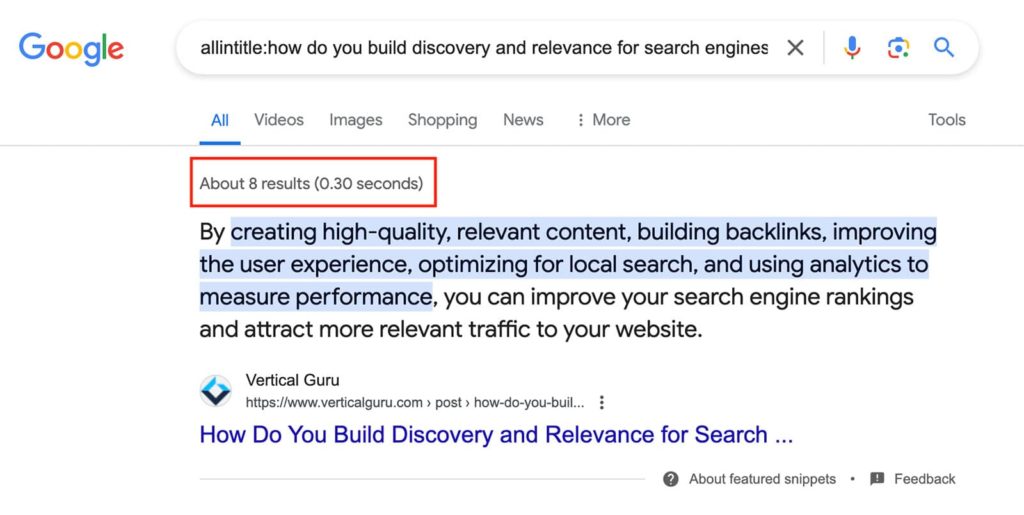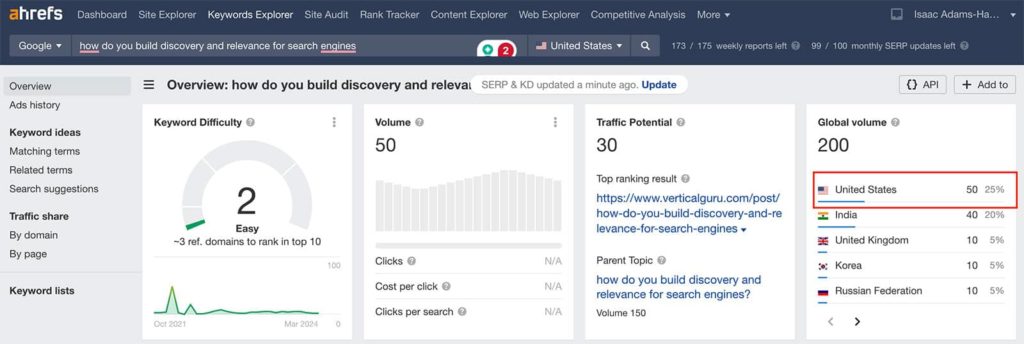The Keyword Golden Ratio (KGR) is a strategic metric developed by SEO expert Doug Cunnington to guide website owners, especially beginners and those with new sites, in discovering low-competition keywords to optimize their content strategy for search engine results pages (SERP). At its core, the KGR method focuses on identifying specific keyword phrases with a low search volume but high potential to drive organic traffic to niche sites, emphasizing a data-driven approach to SEO.
KGR keywords are essentially long-tail keywords that present less competition, making them ideal targets for new websites aiming to gain visibility on Google search without the need for extensive link building or a strong backlink profile.
Table of Contents
The Keyword Golden Ratio (KGR) Formula
The calculation of the KGR involves a simple formula:

Here, the “allintitle” search operator is pivotal, as it helps in determining the number of allintitle results—web pages with titles that exactly match the search term—offering insight into how many competitors are directly targeting the same keyword phrase.
To find KGR terms, SEO tools like SEMrush, Ahrefs, KWfinder, or the Google Keyword Planner can be utilized for keyword research, allowing website owners to assess monthly search volume, keyword difficulty, and even the search intent behind a search phrase. By focusing on keywords with a monthly search volume of less than 250 and a KGR score of less than 0.25, content creators can optimize their web pages more effectively for SEO, improving their chances of appearing on the first page of Google search results.
How to Calculate KGR
The practical steps to apply the Keyword Golden Ratio include:
- Do a broad keyword search.
- Identifying keywords related to your niche with a monthly search volume of less than 250 using a keyword research tool.
- Checking the number of search results that feature the exact keyword in their title tag.
- Calculating the KGR.
- Prioritizing content creation for keywords with a KGR of less than 0.25 to find your target keywords.
A Real-Word Example
To give you a real-world example. I searched for “allintitle:how do you build discovery and relevance for search engines” in Google Search. It showed me eight (8) results.

Then, in Ahrefs (or any other SEO tool you like, e.g., SEMRush), you find the search volume for the country. In this case, it’s 50 searches per month.

So you take the number of Google Search Results with the Exact Keyword in the Title, which is 8, and divide it by the Monthly Search Volume, which is 50, and that gives you 0.16, a perfect Long-Tailed Keword to write an article about.
8/50=0.16KGR scoring:
- Less than 0.25: High chance of your page ranking high
- Between 0.25 and 1.00: Moderate chance to be ranked high
- Higher than 1.00: Poor chance of being ranked high
The aim is to get a KGR score equal to or below 0.25.
Try this out in the calculator below.
Keyword Golden Ratio Calculator
Who is it Best for?
This approach is particularly beneficial for those managing a new website or niche site, where competing against established sites with strong on-page SEO and link-building strategies might be challenging. By leveraging the KGR formula, content creators can prioritize quality content that aligns with search intent, targeting keywords that are within reach and thus more likely to yield a success story by attracting targeted organic traffic.
Pros and Cons of KGR
Here are the pros and cons of using the Keyword Golden Ratio:
Pros
- Quick Wins: The main advantage of KGR is that it can potentially help websites achieve quick rankings for specific keywords. This is particularly beneficial for new websites or those looking to gain traction in a short period.
- Low Competition: By targeting keywords that are less competitive, you have a better chance of ranking higher without needing a strong backlink profile or high domain authority.
- Focused Strategy: KGR provides a clear and focused approach to keyword research, which can be especially helpful for SEO beginners or those looking to streamline their SEO efforts.
- Cost-Effective: Since it targets low-competition keywords, the KGR method can be more cost-effective compared to strategies that target highly competitive keywords, which may require significant investment in content and link building.
- Discovery of Untapped Niches: The process of finding KGR-compliant keywords can lead to the discovery of untapped niches or subtopics that have been overlooked by competitors.
Cons
- Limited Scope: KGR targets very specific, often low-volume search terms. This narrow focus might limit your site’s potential to attract broader traffic or to be seen as an authority on more competitive topics.
- Time-Consuming Process: Finding keywords that meet the KGR criteria can be extremely time-consuming. The process involves a lot of research and analysis to find the right balance between search volume and allintitle results.
- Not Suitable for All Niches: Some niches may not have enough low-competition keywords to effectively apply the KGR method. Highly competitive markets, in particular, might require a more nuanced approach that balances long-tail and high-competition keywords.
- Reliance on Accurate Data: The effectiveness of KGR depends on the accuracy of search volume and competition data. Misleading or inaccurate data can lead to poor keyword choices.
- Potential for Neglecting Quality Content: There’s a risk of prioritizing keywords over content quality. Successful SEO strategies balance the importance of targeting the right keywords with creating valuable, engaging content for users.
- Changes in Search Algorithms: Search engine algorithms are constantly evolving, which can affect the longevity of a KGR strategy. What works today might not work tomorrow if search engines change how they evaluate or rank content.
While the Keyword Golden Ratio can offer a pathway to quick SEO wins for certain low-competition keywords, its effectiveness is contingent on accurate data, the specific niche, and the broader SEO strategy being employed. It’s important to consider these factors and the potential limitations of focusing too narrowly on KGR keywords.
Conclusion
In essence, the KGR method is a powerful SEO strategy that relies on a precise parameter—the ratio of allintitle results to search volume—to identify keyword ideas with the perfect balance of low competition and sufficient search interest. This makes it an invaluable technique for SEO beginners, content strategists, and anyone looking to enhance their site’s visibility with a solid foundation in keyword research and a keen understanding of search engine algorithms.
FAQ
Does Keyword Golden Ratio work?
How do you calculate Keyword Golden Ratio in Excel?
